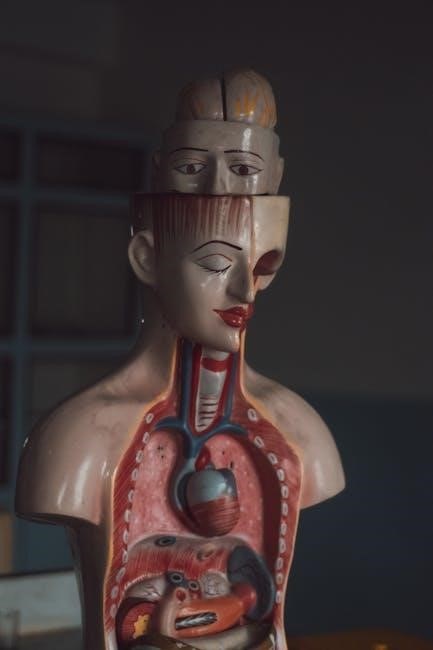
The human body is composed of 11 major systems, each with unique functions essential for survival. These systems include the nervous, circulatory, respiratory, digestive, and endocrine, among others. Understanding their structure and interconnections is crucial for comprehending human health and disease.
1.1 Definition and Overview

Human body systems refer to the organized groups of organs and tissues that work together to perform specific functions necessary for maintaining life. These systems are categorized based on their roles, such as the skeletal, muscular, nervous, circulatory, respiratory, digestive, urinary, endocrine, and integumentary systems. Each system is composed of organs that collaborate to achieve common goals, ensuring the body operates efficiently. The study of these systems is fundamental to understanding human anatomy and physiology, as they interact to maintain homeostasis and overall health. The skeletal system, for instance, provides structural support, while the muscular system enables movement. The nervous system controls bodily functions, and the circulatory system transports essential nutrients and oxygen. These systems are not isolated but function interdependently, highlighting the complexity and interconnectedness of the human body. By examining these systems, we gain insights into how the body adapts to changes and responds to external and internal stimuli, making this knowledge vital for medical and scientific advancements.
1.2 Importance of Studying Human Body Systems
Studying human body systems is essential for understanding how the body functions as a whole. By examining each system’s structure and role, individuals gain insights into the intricate mechanisms that sustain life. This knowledge is crucial for medical professionals, enabling accurate diagnoses and effective treatments. It also aids in disease prevention by highlighting how lifestyle choices impact system health. Moreover, understanding body systems fosters appreciation for human complexity, encouraging healthy habits and informed decision-making. From the nervous system’s control of functions to the circulatory system’s nutrient delivery, each plays a vital role in overall well-being. This study forms the foundation of health sciences, driving advancements in research and patient care. By learning about body systems, individuals can better manage their health and appreciate the interconnectedness of physiological processes. This understanding is not only vital for professionals but also empowers individuals to make informed choices about their well-being and health. Ultimately, studying human body systems is key to improving quality of life and advancing medical knowledge.

The Nervous System
The nervous system is a complex network controlling bodily functions, enabling interaction with the environment. It consists of the brain, spinal cord, and nerves, facilitating communication, movement, and sensory perception. Essential for survival, it regulates both voluntary and involuntary actions.

2.1 Structure and Function
The nervous system operates as a coordinated network, primarily divided into the central nervous system (CNS) and the peripheral nervous system (PNS). The CNS, comprising the brain and spinal cord, acts as the control center, processing information and directing responses. The PNS, consisting of nerves, transmits signals between the CNS and the body’s extremities, enabling communication and movement. Neurons, specialized cells, are the functional units of the nervous system, conducting electrical and chemical signals. Glial cells provide support, maintaining neuronal health and facilitating signal transmission. This intricate structure allows the nervous system to regulate voluntary actions, such as walking, and involuntary processes, like heart rate. The system’s function is to integrate and process sensory information, enabling the body to react to internal and external stimuli effectively. This complex interplay ensures survival, adaptability, and overall bodily coordination.
2.2 Major Components: Brain, Spinal Cord, and Nerves
The nervous system is composed of three primary components: the brain, spinal cord, and nerves. The brain, the control center of the body, regulates thought, emotion, and bodily functions. It is divided into regions like the cerebrum, cerebellum, and brainstem, each performing distinct roles. The spinal cord, extending from the brain, serves as a pathway for nerve signals and controls reflex actions. Nerves, bundles of axons, transmit electrical and chemical signals throughout the body, enabling communication between the CNS and peripheral organs. Sensory nerves carry information to the CNS, while motor nerves transmit signals from the CNS to muscles and glands. This interconnected system ensures precise coordination of bodily functions, from voluntary movements to involuntary processes like digestion. The brain and spinal cord are protected by the meninges and cerebrospinal fluid, while nerves are insulated by myelin sheaths to enhance signal transmission speed. Together, these components form a highly specialized network essential for maintaining life and enabling interaction with the environment.
2.3 Common Disorders and Diseases
The nervous system is susceptible to various disorders and diseases that can significantly impact an individual’s quality of life; Neurodegenerative diseases, such as Alzheimer’s and Parkinson’s, progressively damage brain cells, leading to memory loss, motor dysfunction, and cognitive decline. Multiple sclerosis (MS) is an autoimmune condition that disrupts communication between the brain and body by damaging the myelin sheath surrounding nerve fibers.
Other common conditions include epilepsy, characterized by recurrent seizures due to abnormal electrical activity in the brain, and stroke, which occurs when blood flow to the brain is interrupted, causing tissue damage. Mental health disorders like schizophrenia and bipolar disorder are also linked to imbalances in neurotransmitters and brain function.
Infections such as meningitis and encephalitis can inflame the protective layers of the nervous system, leading to severe symptoms. Additionally, nerve-related conditions like peripheral neuropathy and Guillain-Barré syndrome can cause numbness, weakness, or paralysis. Early diagnosis and treatment are critical to managing these conditions and improving outcomes. Understanding these disorders highlights the importance of maintaining nervous system health.

The Circulatory System
The circulatory system, also known as the cardiovascular system, transports oxygen, nutrients, and hormones throughout the body while removing waste products. It consists of the heart, blood vessels, and blood, playing a vital role in maintaining overall health and bodily functions.
3.1 Blood and Blood Vessels
Blood is a vital fluid composed of plasma, red blood cells (RBCs), white blood cells (WBCs), and platelets. RBCs carry oxygen throughout the body, while WBCs help fight infections. Platelets are essential for blood clotting, preventing excessive bleeding during injuries.
Blood vessels form a network of tubes that transport blood to tissues and organs. They include arteries, veins, and capillaries. Arteries carry oxygen-rich blood away from the heart, while veins return oxygen-depleted blood to it. Capillaries, the smallest vessels, enable the exchange of oxygen, nutrients, and waste products with cells.
The circulatory system relies on blood vessels to regulate blood flow and pressure. Their flexible walls adjust to changes in blood volume, ensuring proper distribution of nutrients and maintenance of homeostasis. This intricate system is crucial for sustaining life and overall bodily functions.
3.2 The Heart and Its Functions
The heart is a muscular, hollow organ that serves as the central pump of the circulatory system. Located in the thoracic cavity, it is divided into four chambers: the left and right atria, and the left and right ventricles. The atria receive blood returning to the heart, while the ventricles pump blood out to the body and lungs. A septum separates the left and right sides, preventing blood from mixing.
The heart’s primary function is to pump blood throughout the body, delivering oxygen and nutrients to tissues and organs while removing carbon dioxide and other waste products. It achieves this through a rhythmic contraction and relaxation cycle controlled by the sinoatrial node, the heart’s natural pacemaker. The heart valves ensure blood flows in one direction, preventing backflow.
The heart muscle, or myocardium, is thick and powerful, enabling it to pump approximately 2,000 gallons of blood daily. Its functions are vital for maintaining blood pressure, supplying oxygen to cells, and supporting overall bodily functions. A healthy heart is essential for survival, emphasizing the importance of cardiovascular health.
3.3 Common Conditions Affecting the Circulatory System

The circulatory system is susceptible to various disorders that can significantly impact overall health. One of the most prevalent conditions is hypertension, or high blood pressure, which can damage blood vessels and lead to complications like heart failure or stroke. Atherosclerosis is another common issue, characterized by the buildup of plaque in arterial walls, narrowing blood flow and increasing the risk of heart attacks or peripheral artery disease.
Coronary artery disease occurs when the coronary arteries, which supply blood to the heart, become blocked, leading to chest pain (angina) or myocardial infarction (heart attack). Peripheral artery disease affects blood flow to the limbs, often causing pain during physical activity. Additionally, conditions like aneurysms (bulges in blood vessel walls) and varicose veins (enlarged, twisted veins) are common and can lead to serious complications if untreated.
Lifestyle factors such as smoking, obesity, and lack of exercise contribute to these conditions. Early diagnosis and treatment, including medications, lifestyle changes, and surgical interventions, are crucial for managing circulatory disorders and preventing long-term damage.

The Respiratory System
The respiratory system facilitates the exchange of oxygen and carbon dioxide through breathing. It includes the lungs, trachea, and bronchi, essential for oxygenating blood and maintaining overall health by supplying oxygen to cells and removing waste gases.
4.1 The Process of Breathing
Breathing is a vital function that involves the inhalation and exhalation of air, enabling gas exchange between the lungs and the bloodstream. The process begins with inhalation, where air enters the nostrils or mouth, passes through the pharynx, and moves into the trachea (windpipe). The trachea branches into bronchi, which lead to the lungs. Inside the lungs, bronchi further divide into smaller bronchioles, eventually reaching alveoli, tiny air sacs where oxygen diffuses into the blood and carbon dioxide is removed.
Exhalation occurs when the diaphragm relaxes, reducing chest cavity volume, and air is pushed out of the lungs. This process is controlled by the autonomic nervous system, with the brainstem regulating breathing rates based on carbon dioxide levels. Breathing is essential for delivering oxygen to cells and removing waste gases, maintaining cellular respiration and overall bodily functions. Factors like physical activity, emotions, and health conditions can influence breathing patterns, emphasizing its dynamic and critical role in human physiology.
4.2 Major Organs: Lungs, Trachea, and Bronchi
The respiratory system relies on several key organs to facilitate breathing and gas exchange. The lungs are the primary organs responsible for exchanging oxygen and carbon dioxide through the alveoli, tiny sacs where blood vessels facilitate this process. Protected by the ribcage, the lungs are divided into lobes, with the right lung having three lobes and the left lung having two.
The trachea, or windpipe, is a tube that connects the throat to the bronchi, serving as the main pathway for air entering and exiting the lungs. It is lined with mucus membranes and cilia, which help filter and remove dust and pathogens from inhaled air. The trachea splits into the right and left bronchi, which lead to the respective lungs.
The bronchi further divide into smaller bronchioles within the lungs, eventually reaching the alveoli. This extensive network ensures efficient gas exchange and oxygen delivery to the bloodstream. Together, the lungs, trachea, and bronchi form a critical pathway for air and are essential for maintaining proper respiratory function and overall health. Their coordinated structure and function enable the body to obtain the oxygen necessary for cellular metabolism.
4.3 Respiratory Disorders and Diseases
The respiratory system is susceptible to various disorders and diseases that can impair its function and overall health. One of the most common conditions is asthma, a chronic inflammatory disease characterized by airway constriction, wheezing, and shortness of breath. Chronic obstructive pulmonary disease (COPD) is another prevalent condition, often caused by smoking or long-term exposure to pollutants, leading to irreversible damage to the lungs.
Pneumonia, an infection caused by bacteria, viruses, or fungi, inflames the alveoli, making breathing painful and limiting oxygen absorption. Tuberculosis (TB) is a bacterial infection that primarily affects the lungs, causing coughing, weight loss, and fatigue. Bronchitis, both acute and chronic, involves inflammation of the bronchi, often accompanied by coughing and mucus production.
Other conditions include lung cancer, which can result from smoking or environmental carcinogens, and cystic fibrosis, a genetic disorder that thickens mucus, obstructing airways. Respiratory disorders can significantly impact quality of life and require medical intervention, such as medications, therapies, or surgeries, to manage symptoms and prevent complications. Early diagnosis and treatment are critical for improving outcomes.

The Digestive System
The digestive system is essential for breaking down food into nutrients for energy and growth. It includes the mouth, esophagus, stomach, small intestine, and large intestine, working together to ensure proper nutrient absorption and maintain overall health effectively.
5.1 The Role of the Digestive System in Nutrient Absorption
The digestive system plays a vital role in nutrient absorption by breaking down food into smaller molecules that can be utilized by the body for energy, growth, and repair. This process begins in the mouth, where saliva containing enzymes like amylase starts to break down carbohydrates. The food then travels through the esophagus into the stomach, where gastric juices and enzymes further dismantle proteins and fats.
In the small intestine, most nutrient absorption occurs. The walls of the small intestine are lined with finger-like projections called villi, which increase the surface area for absorption. Specialized enzymes from the pancreas and bile from the liver further break down nutrients into simpler forms like glucose, amino acids, and fatty acids. These molecules are absorbed into the bloodstream through the intestinal walls and transported to the liver for processing and distribution to the rest of the body.
The large intestine absorbs water and electrolytes, solidifying waste for elimination. Overall, the digestive system ensures that the body receives the necessary nutrients to function optimally, making it a cornerstone of human health and survival.
5.2 Key Organs: Stomach, Liver, and Pancreas
The digestive system relies on several key organs to ensure proper digestion and nutrient processing. The stomach is a muscular sac that mechanically breaks down food through churning and mixes it with digestive enzymes like pepsin and gastric amylase. Its lining secretes mucus to protect itself from acidic digestive juices, ensuring efficient digestion without self-damage.
The liver plays a dual role in digestion and metabolism. It produces bile, which is stored in the gallbladder and released into the small intestine to emulsify fats, aiding in their absorption. The liver also detoxifies harmful substances, regulates blood sugar levels, and metabolizes nutrients for energy production.
The pancreas contributes to digestion by secreting digestive enzymes into the small intestine, such as amylase, lipase, and trypsin, which break down carbohydrates, fats, and proteins, respectively. Additionally, the pancreas produces hormones like insulin and glucagon, regulating blood sugar levels and ensuring proper energy utilization throughout the body.
Together, these organs work harmoniously to break down food, absorb nutrients, and maintain metabolic balance, highlighting their critical roles in overall health and bodily function.
5.3 Common Digestive Disorders
The digestive system is prone to various disorders that can disrupt its normal functioning. One of the most common conditions is irritable bowel syndrome (IBS), characterized by abdominal pain, bloating, and irregular bowel movements. It is often triggered by stress or certain foods. Another prevalent disorder is inflammatory bowel disease (IBD), which includes Crohn’s disease and ulcerative colitis, causing inflammation and damage to the digestive tract.
Gastroesophageal reflux disease (GERD) is another common issue, where stomach acid flows back into the esophagus, leading to heartburn and discomfort. Peptic ulcers, which are open sores in the stomach lining or the upper part of the small intestine, can cause severe pain and bleeding if left untreated. Additionally, celiac disease is an autoimmune disorder triggered by gluten, damaging the small intestine and impairing nutrient absorption.
These disorders highlight the importance of maintaining a healthy diet, managing stress, and seeking timely medical care to prevent complications. Early diagnosis and appropriate treatment can significantly improve quality of life for individuals affected by these conditions. Proper care ensures the digestive system functions optimally, supporting overall health and well-being.

The Endocrine System
The endocrine system is a network of glands and organs that produce and regulate hormones, which are chemical messengers that control various bodily functions. These hormones are released directly into the bloodstream and travel to target cells, influencing processes such as growth, metabolism, reproduction, and energy levels. The endocrine system works closely with the nervous system to maintain homeostasis and ensure proper bodily functions.

Key components of the endocrine system include the pancreas, thyroid gland, adrenal glands, and pituitary gland. The pancreas produces insulin and glucagon to regulate blood sugar levels, while the thyroid gland releases hormones that control metabolism. The adrenal glands produce adrenaline and cortisol, which are vital for stress responses and maintaining blood pressure; The pituitary gland, often referred to as the “master gland,” regulates the activity of other endocrine glands.
Overall, the endocrine system plays a critical role in maintaining health by coordinating and balancing the body’s internal processes. Its proper functioning is essential for growth, development, and overall well-being. Any imbalance or disruption in hormone production can lead to various health disorders, emphasizing the importance of this system in human physiology.